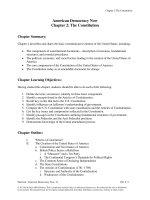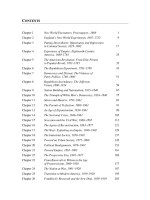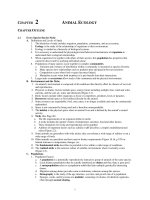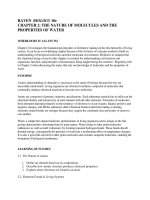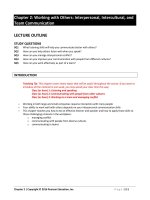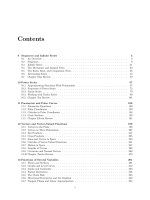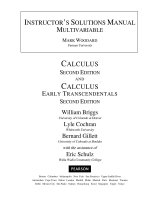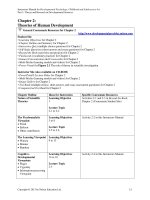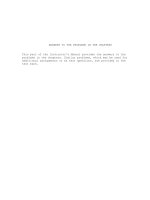Test band and solution of chemistry 4e (1)
Bạn đang xem bản rút gọn của tài liệu. Xem và tải ngay bản đầy đủ của tài liệu tại đây (426.36 KB, 32 trang )
Burdge Chemistry 4e Chapter 2 ISM.pdf
Chapter_02_IM_4e.pdf
Chapter 2
Atoms, Molecules, and Ions
Practice Problems C
2.1
(ii) and (iii)
2.2
(i) 14N, (ii) 21Na, (iii) 15O
2.3
(i) 2.9177 g
(ii) 3.4679 g
(iii) 3.4988 g
2.4
Fe(NO3)2, iron(II) nitrate
2.5
CuSO3, copper(II) sulfite
2.6
(i) and (iv)
2.7
4 ethanol molecules; all C used, 1 O left over, 3 H left over
2.8
selenium hexachloride
2.9
2.10
(ii) and (iv)
2.11
formaldehyde and glucose
Applying What You’ve Learned
a)
There are 54 – 26 = 28 neutrons in the 54Fe nucleus, 30 neutrons in the 56Fe nucleus, 31 neutrons in the 57Fe
nucleus, and 32 neutrons in the 58Fe nucleus.
b)
The average atomic mass of iron is 55.845 amu.
c)
The molecular formula for ascorbic acid is C6H8O6.
d)
The empirical formula for ascorbic acid is C3H4O3.
Copyright © McGraw‐Hill Education. All rights reserved.
No reproduction or distribution without the prior written consent of McGraw‐Hill Education.
Chapter 2 – Atoms, Molecules, and Ions
e)
The formula for ferrous sulfate is FeSO4.
Questions and Problems
2.1
1. Elements are composed of extremely small particles called atoms. All atoms of a given element are
identical, having the same size, mass, and chemical properties. The atoms of one element are different from
the atoms of all other elements.
2. Compounds are composed of atoms of more than one element. In any given compound, the same types
of atoms are always present in the same relative numbers.
3. A chemical reaction rearranges atoms in chemical compounds; it does not create or destroy them.
2.2
The law of definite proportions states that different samples of a given compound always contain the same
elements in the same mass ratio.
The law of multiple proportions states that if two elements can combine to form more than one compound
with each other, the masses of one element that combine with a fixed mass of the other element are in ratios
of small whole numbers.
2.3
2.4
ratio of P to Cl in compound 1 0.2912
1.667 5 : 3
ratio of P to Cl in compound 2 0.1747
2.5
ratio of F to S in S2 F10 2.962
1.250
ratio of F to S in SF4
2.370
ratio of F to S in SF6 3.555
1.5
ratio of F to S in SF4 2.370
ratio of F to S in SF4
1
ratio of F to S in SF4
ratio in SF6 : ratio in S2 F10 : ratio in SF4 1.5 :1.25 :1
Multiply through to get all whole numbers. 4 1.5 :1.25 :1 6 : 5 : 4
Copyright © McGraw‐Hill Education. All rights reserved.
No reproduction or distribution without the prior written consent of McGraw‐Hill Education.
2
Chapter 2 – Atoms, Molecules, and Ions
2.6
ratio of O to Fe in FeO
0.2865
0.667 2 : 3
ratio of O to Fe in Fe 2 O3 0.4297
2.7
g blue: 1.00 g red (right) 2 / 3
0.667 2 : 3
g blue: 1.00 g red (left)
1/1
2.8
g green: 1.00 g orange (right) 4 / 2
0.667 : 1 2 : 3
g green: 1.00 g orange (left)
3 /1
2.9
a. An α particle is a positively charged particle consisting of two protons and two neutrons, emitted in
radioactive decay or nuclear fission.
b. A β particle is a high-speed electron, especially emitted in radioactive decay.
c. γ rays are high-energy electromagnetic radiation emitted by radioactive decay.
d. X-rays are a form of electromagnetic radiation similar to light but of shorter wavelength.
2.10
alpha rays, beta rays, and gamma rays
2.11
α particles are deflected away from positively charged plates. Cathode rays are drawn toward positively
charged plates. Protons are positively charged particles in the nucleus. Neutrons are electrically neutral
subatomic particles in the nucleus. Electrons are negatively charged particles that are distributed around the
nucleus.
2.12
J .J. Thomson determined the ratio of electric charge to the mass of an individual electron.
R. A. Millikan calculated the mass of an individual electron and proved the charge on each electron was
exactly the same.
Ernest Rutherford proposed that an atom’s positive charges are concentrated in the nucleus and that most of
the atom is empty space.
James Chadwick discovered neutrons.
2.13
Rutherford bombarded gold foil with α particles. Most of them passed through the foil, while a small
proportion were deflected or reflected. Thus, most of the atom must be empty space through which the α
particles could pass without encountering any obstructions.
Copyright © McGraw‐Hill Education. All rights reserved.
No reproduction or distribution without the prior written consent of McGraw‐Hill Education.
3
Chapter 2 – Atoms, Molecules, and Ions
2.14
First, convert 1 cm to picometers.
1 cm
0.01 m
1 pm
1 1010 pm
12
1 cm
1 10
m
(1 1010 pm)
2.15
1 He atom
1 102 pm
Note that you are given information to set up the conversion factor relating meters and miles.
ratom 104 rnucleus 104 2.0 cm
2.16
1 108 He atoms
1m
1 mi
0.12 mi
100 cm 1609 m
Atomic number is the number of protons in the nucleus of each atom of an element. It determines the
chemical identity of the element. There are 2 protons in each atom of helium-4.
Mass number is the total number of neutrons and protons present in the nucleus of an atom of an element.
The mass number of helium-4 is 4. There are (4 – 2) = 2 neutrons in each atom.
Because atoms are electrically neutral, the number of protons and electrons must be equal. The atomic
number is also the number of electrons in each atom.
2.17
The atomic number is the number of protons in the nucleus. It determines the chemical identity of the
element. If an atom has a different number of protons (a different atomic number), it is a different element.
2.18
isotopes
2.19
X is the element symbol. It indicates the chemical identity of the atom.
A is the mass number. It is the number of protons plus the number of neutrons.
Z is the atomic number. It is the number of protons.
2.20
For iron, the atomic number Z is 26. Therefore the mass number A is:
A = 26 + 28 = 54
2.21
Strategy: The 239 in Pu-239 is the mass number. The mass number (A) is the total number of neutrons
and protons present in the nucleus of an atom of an element. You can look up the atomic
number (number of protons) on the periodic table.
Copyright © McGraw‐Hill Education. All rights reserved.
No reproduction or distribution without the prior written consent of McGraw‐Hill Education.
4
5
Chapter 2 – Atoms, Molecules, and Ions
mass number = number of protons + number of neutrons
Solution:
number of neutrons = mass number number of protons = 239 94 = 145
2.22
2.23
3
2 He
4
2 He
24
12 Mg
25
12 Mg
48
22Ti
79
35 Br
195
78 Pt
No. Protons
2
2
12
12
22
35
78
No. Neutrons
1
2
12
13
26
44
117
15
7N
33
16 S
63
29 Cu
84
38 Sr
130
56 Ba
186
74W
202
80 Hg
No. Protons
7
16
29
38
56
74
80
No. Electrons
7
16
29
38
56
74
80
No. Neutrons
8
17
34
46
74
112
122
Isotope
Isotope
a.
2.25
The accepted way to denote the atomic number and mass number of an element X is
23
11 Na
b.
64
28 Ni
c.
d.
2.24
115
50 Sn
42
20 Ca
A
ZX
where A mass
number and Z atomic number.
a.
186
74W
b.
201
80 Hg
c.
76
34 Se
d.
239
94 Pu
2.26
a. 11
b. 25
c. 80
d. 199
2.27
a. 20
b. 32
c. 78
d. 198
2.28
198
2.29
The periodic table is a chart in which elements having similar chemical and physical properties are grouped
together.
Au: 119 neutrons, 47Ca: 27 neutrons, 60Co: 33 neutrons, 18F: 9 neutrons, 125I: 72 neutrons, 131I: 78
neutrons, 42K: 23 neutrons, 43K: 24 neutrons, 24Na: 13 neutrons, 32P: 17 neutrons, 85Sr: 47 neutrons, 99Tc:
56 neutrons.
Copyright © McGraw‐Hill Education. All rights reserved.
No reproduction or distribution without the prior written consent of McGraw‐Hill Education.
6
Chapter 2 – Atoms, Molecules, and Ions
2.30
A metal is a good conductor of heat and electricity, whereas a nonmetal is usually a poor conductor of heat
and electricity.
2.31
Answers will vary.
2.32
Answers will vary.
2.33
Strontium has similar chemical properties to calcium, which is an important mineral for humans.
2.34
Helium and Selenium are nonmetals whose name ends with ium. (Tellurium is a metalloid whose name
ends in ium.)
2.35
a. Metallic character increases as you progress down a group of the periodic table. For example, moving
down Group 4A, the nonmetal carbon is at the top and the metal lead is at the bottom of the group.
b. Metallic character decreases from the left side of the table (where the metals are located) to the right side
of the table (where the nonmetals are located).
2.36
a. Li (0.53 g/cm3)
K (0.86 g/cm3)
H2O (0.98 g/cm3)
b. Au (19.3 g/cm3)
Pt (21.4 g/cm3)
Hg (13.6 g/cm3)
c. Os (22.6 g/cm3)
d. Te (6.24 g/cm3)
2.37
Na and K are both Group 1A elements; they should have similar chemical properties. N and P are both
Group 5A elements; they should have similar chemical properties. F and Cl are Group 7A elements; they
should have similar chemical properties.
2.38
I and Br (both in Group 7A), O and S (both in Group 6A), Ca and Ba (both in Group 2A)
Copyright © McGraw‐Hill Education. All rights reserved.
No reproduction or distribution without the prior written consent of McGraw‐Hill Education.
7
Chapter 2 – Atoms, Molecules, and Ions
2.39
1A
8A
2A
Na
Mg
3A
3B
4B
5B
6B
7B
⌐−
8B
−¬
1B
2B
4A
5A
6A
P
S
7A
Fe
I
Atomic number 26, iron, Fe, (present in hemoglobin for transporting oxygen)
Atomic number 53, iodine, I, (present in the thyroid gland)
Atomic number 11, sodium, Na, (present in intra- and extra-cellular fluids)
Atomic number 15, phosphorus, P, (present in bones and teeth)
Atomic number 16, sulfur, S, (present in proteins)
Atomic number 12, magnesium, Mg, (present in chlorophyll molecules)
2.40
An atomic mass unit (amu) is defined as a mass exactly equal to one-twelfth the mass of one carbon-12
atom. Setting the atomic mass of carbon-12 at 12 amu provides the standard for measuring the atomic mass
of the other elements, since the mass of a single atom cannot be measured.
2.41
The mass of a carbon-12 atom is exactly 12 amu. The mass on the periodic table is the average mass of
naturally occurring carbon, which is a mixture of several carbon isotopes.
2.42
The average mass of the naturally occurring isotopes of gold, taking into account their natural abundances, is
197.0 amu.
2.43
To calculate the average atomic mass of an element, you must know the identity and natural abundances of
all naturally occurring isotopes of the element.
Copyright © McGraw‐Hill Education. All rights reserved.
No reproduction or distribution without the prior written consent of McGraw‐Hill Education.
Chapter 2 – Atoms, Molecules, and Ions
2.44
2.45
(78.9183361 amu)(0.5069) (80.916289 amu)(0.4931) 79.90 amu
(203.973020 amu)(0.014) (205.974440 amu)(0.241) +(206.975872 amu)(0.221) (207.976627
amu)(0.524) 207.2 amu
2.46
The fractional abundances of the two isotopes of Tl must add to 1. Therefore, we can write
(202.972320 amu)(x) (204.974401 amu)(1 x) 204.4 amu
Solving for x gives 0.2869. Therefore, the natural abundances of 203Tl and 205Tl are 28.69% and 71.31%,
respectively.
2.47
Strategy: Each isotope contributes to the average atomic mass based on its relative abundance.
Multiplying the mass of an isotope by its fractional abundance (not percent) will give the
contribution to the average atomic mass of that particular isotope.
It would seem that there are two unknowns in this problem, the fractional abundance of 6Li and
the fractional abundance of 7Li. However, these two quantities are not independent of each
other; they are related by the fact that they must sum to 1. Start by letting x be the fractional
abundance of 6Li. Since the sum of the two fractional abundances must be 1, we can write
(6.0151 amu)(x) (7.0160 amu)(1 x) 6.941 amu
Solution: Solving for x gives 0.075, which corresponds to the fractional abundance of 6Li. The fractional
abundance of 7Li is (1 x) = 0.925. Therefore, the natural abundances of 6Li and 7Li are 7.5%
and 92.5%, respectively.
2.48
The conversion factor required is
6.022 1023 amu
1g
13.2 amu
2.49
The conversion factor required is
1g
23
6.022 10 amu
2.19 1023 g
6.022 1023 amu
1g
8.4 g
6.022 1023 amu
= 5.1 1024 amu
1g
Copyright © McGraw‐Hill Education. All rights reserved.
No reproduction or distribution without the prior written consent of McGraw‐Hill Education.
8
9
Chapter 2 – Atoms, Molecules, and Ions
2.50
Answers will vary.
2.51
An ionic compound consists of anions and cations. The ratio of anions and cations is such that the net
charge is zero.
2.52
The formulas of ionic compounds are generally empirical formulas because an ionic compound consists of a
vast array of interspersed cations and anions called a lattice, not discrete molecular units.
2.53
The Stock system uses Roman numerals to indicate the charge on cations of metals that commonly have
more than one possible charge. This eliminates the need to know which charges are common on all the
transition metals.
2.54
Answers will vary. Example: NH4Cl
2.55
The atomic number (Z) is the number of protons in the nucleus of each atom of an element. You can find
this on a periodic table. The number of electrons in an ion is equal to the number of protons minus the
charge on the ion.
number of electrons (ion) number of protons charge on the ion
2.56
2.57
Ion
Na
Ca2
Al3
Fe2
I
F
S2
O2
N3
No. protons
11
20
13
26
53
9
16
8
7
No. electrons
10
18
10
24
54
10
18
10
10
Ion
K
Mg2
Fe3
Br
Mn2
C4
Cu2
No. protons
19
12
26
35
25
6
29
No. electrons
18
10
23
36
23
10
27
a. Sodium ion has a +1 charge and oxide has a 2 charge. The correct formula is Na2O.
b. The iron ion has a +2 charge and sulfide has a 2 charge. The correct formula is FeS.
c. The correct formula is Co2(SO4)3.
d. Barium ion has a +2 charge and fluoride has a 1 charge. The correct formula is BaF2.
Copyright © McGraw‐Hill Education. All rights reserved.
No reproduction or distribution without the prior written consent of McGraw‐Hill Education.
Chapter 2 – Atoms, Molecules, and Ions
2.58
a. The copper ion has a +1 charge and bromide has a 1 charge. The correct formula is CuBr.
b. The manganese ion has a +3 charge and oxide has a 2 charge. The correct formula is Mn2O3.
c. We have the Hg2 ion and iodide (I). The correct formula is Hg2I2.
2
d. Magnesium ion has a +2 charge and phosphate has a 3 charge. The correct formula is Mg3(PO4)2.
2.59
Compounds of metals with nonmetals are usually ionic. Nonmetal-nonmetal compounds are usually
molecular.
Ionic:
LiF, BaCl2, KCl
Molecular:
2.60
Compounds of metals with nonmetals are usually ionic. Nonmetal-nonmetal compounds are usually
molecular.
Ionic:
NaBr, BaF2, CsCl.
Molecular:
2.61
SiCl4, B2H6, C2H4
CH4, CCl4, ICl, NF3
Strategy: When naming ionic compounds, our reference for the names of cations and anions are Tables
2.8 and 2.9 of the text. Keep in mind that if a metal can form cations of different charges, we
need to use the Stock system. In the Stock system, Roman numerals are used to specify the
charge of the cation. The metals that have only one charge in ionic compounds are the alkali
metals (+1), the alkaline earth metals (+2), Ag, Zn2, Cd2, and Al3.
When naming acids, binary acids are named differently than oxoacids. For binary acids, the
name is based on the nonmetal. For oxoacids, the name is based on the polyatomic anion. For
more detail, see Section 2.7 of the text.
Solution: a. This is an ionic compound in which the metal cation (K+) has only one charge. The correct
name is potassium dihydrogen phosphate.
b. This is an ionic compound in which the metal cation (K) has only one charge. The correct
name is potassium hydrogen phosphate
c. This is molecular compound. In the gas phase, the correct name is hydrogen bromide.
Copyright © McGraw‐Hill Education. All rights reserved.
No reproduction or distribution without the prior written consent of McGraw‐Hill Education.
10
Chapter 2 – Atoms, Molecules, and Ions
d. The correct name of this compound in water is hydrobromic acid.
e. This is an ionic compound in which the metal cation (Li+) has only one charge. The correct
name is lithium carbonate.
f. This is an ionic compound in which the metal cation (K) has only one charge. The correct
name is potassium dichromate.
g. This is an ionic compound in which the cation is a polyatomic ion with a charge of +1. The
anion is an oxoanion with one less O atom than the corresponding –ate ion (nitrate). The
correct name is ammonium nitrite.
h. The oxoanion in this acid is analogous to the chlorate ion. The correct name of this
compound is hydrogen iodate (in water, iodic acid)
i. This is a molecular compound. We use a prefix to denote how many F atoms it contains.
The correct name is phosphorus pentafluoride.
j. This is a molecular compound. We use prefixes to denote the numbers of both types of atom.
The correct name is tetraphosphorus hexoxide.
k. This is an ionic compound in which the metal cation (Cd) has only one charge. The correct
name is cadmium iodide.
l. This is an ionic compound in which the metal cation (Sr) has only one charge. The correct
name is strontium sulfate.
m. This is an ionic compound in which the metal cation (Al) has only one charge. The correct
name is aluminum hydroxide.
2.62
a. potassium hypochlorite
h. iron(III) oxide
b. silver carbonate
i. titanium(IV) chloride
c. nitrous acid
j. sodium hydride
Copyright © McGraw‐Hill Education. All rights reserved.
No reproduction or distribution without the prior written consent of McGraw‐Hill Education.
11
Chapter 2 – Atoms, Molecules, and Ions
d. potassium permanganate
k. lithium nitride
e. cesium chlorate
l. sodium oxide
f. potassium ammonium sulfate
m. sodium peroxide
g. iron(II) oxide
2.63
Strategy: When writing formulas of molecular compounds, the prefixes specify the number of each type
of atom in the compound.
When writing formulas of ionic compounds, the subscript of the cation is numerically equal to
the charge of the anion, and the subscript of the anion is numerically equal to the charge on the
cation. If the charges of the cation and anion are numerically equal, then no subscripts are
necessary. Charges of common cations and anions are listed in Tables 2.8 and 2.9 of the text.
Keep in mind that Roman numerals specify the charge of the cation, not the number of metal
atoms. Remember that a Roman numeral is not needed for some metal cations, because the
charge is known. These metals are the alkali metals (1), the alkaline earth metals (2), Ag,
Zn2, Cd2, and Al3.
When writing formulas of oxoacids, you must know the names and formulas of polyatomic
anions (see Table 2.9 of the text).
Solution: a. Rubidium is an alkali metal. It only forms a +1 cation. The polyatomic ion nitrite, NO ,
2
has a 1 charge. Because the charges on the cation and anion are numerically equal, the ions
combine in a one-to-one ratio. The correct formula is RbNO2.
b. Potassium is an alkali metal. It only forms a 1 cation. The anion, sulfide, has a charge of
2. Because the charges on the cation and anion are numerically different, the subscript of
the cation is numerically equal to the charge on the anion, and the subscript of the anion is
numerically equal to the charge on the cation. The correct formula is K2S.
c. Sodium is an alkali metal. It only forms a +1 cation. The anion is the hydrogen sulfide ion (the
sulfide ion plus one hydrogen), HS. Because the charges are numerically the same, the ions
combine in a one-to-one ratio. The correct formula is NaHS.
d. Magnesium is an alkaline earth metal. It only forms a +2 cation. The polyatomic phosphate
anion has a charge of 3, PO 34 . Because the charges on the cation and anion are
numerically different, the subscript of the cation is numerically equal to the charge on the
Copyright © McGraw‐Hill Education. All rights reserved.
No reproduction or distribution without the prior written consent of McGraw‐Hill Education.
12
13
Chapter 2 – Atoms, Molecules, and Ions
anion, and the subscript of the anion is numerically equal to the charge on the cation. The
correct formula is Mg3(PO4)2. Note that for its subscript to be changed, a polyatomic ion
must be enclosed in parentheses.
e. Calcium is an alkaline earth metal. It only forms a 2 cation. The polyatomic ion hydrogen
phosphate, HPO 24 , has a 2 charge. Because the charges are numerically the same, the ions
combine in a one-to-one ratio. The correct formula is CaHPO4.
f. Lead (II), Pb2+, is a cation with a charge . The polyatomic ion carbonate, CO 2 , has a 2
3
charge. Because the charges on the cation and anion are numerically equal, the ions
combine in a one-to-one ratio. The correct formula is PbCO3.
g. Tin (II), Sn2+, is a cation with a charge of +2. The anion, fluoride, has a change of –1.
Because the charges on the cation and anion are numerically different, the subscript of the
cation is numerically equal to the charge on the anion, and the subscript of the anion is
numerically equal to the charge on the cation. The correct formula is SnF2.
h. The polyatomic ion ammonium, NH , has a 1 charge and the polyatomic ion sulfate, SO 2
4
4
, has a 2 charge. To balance the charge, we need 2 NH 4 cations. The correct formula is
(NH4)2SO4.
i. Silver forms only a +1 ion. The perchlorate ion, ClO , has a charge of 1. Because the
4
charges are numerically the same, the ions combine in a one-to-one ratio. The correct formula is
AgClO4.
j. This is a molecular compound. The Greek prefixes tell you the number of each type of atom
in the molecule: no prefix indicates 1 and tri- indicates 3. The correct formula is BCl3.
2.64
a. CuCN
d. HI(aq)
g. IF7
j. Hg2I2
b. Sr(ClO2)2
e. Na2(NH4)PO4
h. P4S10
k. SeF6
c. HBrO4(aq)
f. KH2PO4
i. HgO
Copyright © McGraw‐Hill Education. All rights reserved.
No reproduction or distribution without the prior written consent of McGraw‐Hill Education.
14
Chapter 2 – Atoms, Molecules, and Ions
2.65
a. Mg(NO3)2
b. Al2O3
2.66
a. one green sphere, one red sphere
b. LiH
b. Na2S
b. one green sphere, two red spheres
c. three green spheres, two red spheres
d. two green spheres, one red sphere
2.67
A molecule is a combination of at least two atoms in a specific arrangement held together by electrostatic
forces known as covalent chemical bonds.
2.68
An allotrope is one of two or more distinct forms of an element. For example, diamond and graphite are two
allotropes of carbon. Allotropes have different chemical bonding of atoms of the same element. Isotopes
have different nuclear structures.
2.69
A chemical formula denotes the composition of the substance.
a. 1:1
b. 1:3
c. 2:4 = 1:2
d. 4:6 = 2:3
2.70
A molecular formula shows the exact number of atoms of each element in a molecule. An empirical formula
shows the lowest whole number ratio of the atoms of each element in a molecule.
2.71
Answers will vary. Example: C2H4 and C4H8
2.72
Organic compounds contain carbon and hydrogen, sometimes in combination with other elements such as
oxygen, nitrogen, sulfur, and the halogens. Inorganic compounds generally do not contain carbon, although
some carbon-containing species are considered inorganic.
Copyright © McGraw‐Hill Education. All rights reserved.
No reproduction or distribution without the prior written consent of McGraw‐Hill Education.
Chapter 2 – Atoms, Molecules, and Ions
2.73
Answers will vary.
Binary: carbon dioxide, CO2
Ternary: dichloromethane, CH2Cl2
2.74
HCl in the gas phase is hydrogen chloride, a molecular compound. When dissolved in water, it dissociates
completely into ions and is hydrochloric acid.
2.75
a. This is a polyatomic molecule that is an elemental form of the substance. It is not a compound.
b. This is a polyatomic molecule that is a compound.
c. This is a diatomic molecule that is a compound.
2.76
a. This is a diatomic molecule that is a compound.
b. This is a polyatomic molecule that is a compound.
c. This is a polyatomic molecule that is the elemental form of the substance. It is not a compound.
2.77
2.78
2.79
Elements:
N2, S8, H2
Compounds:
NH3, NO, CO, CO2, SO2
There are more than two correct answers for each part of the problem.
a. H2 and F2
c. S8 and P4
b. HCl and CO
d. H2O and C12H22O11 (sucrose)
Strategy: An empirical formula tells us which elements are present and the simplest whole-number ratio
of their atoms. Can you divide the subscripts in the formula by a common factor to end up with
smaller whole-number subscripts?
Copyright © McGraw‐Hill Education. All rights reserved.
No reproduction or distribution without the prior written consent of McGraw‐Hill Education.
15
16
Chapter 2 – Atoms, Molecules, and Ions
Solution: a. Dividing both subscripts by 2, the simplest whole number ratio of the atoms in C2N2 is CN.
b. Dividing all subscripts by 6, the simplest whole number ratio of the atoms in C6H6 is CH.
c. The molecular formula as written, C9H20, contains the simplest whole number ratio of the
atoms present. In this case, the molecular formula and the empirical formula are the same.
d. Dividing all subscripts by 2, the simplest whole number ratio of the atoms in P4O10 is P2O5.
e. Dividing all subscripts by 2, the simplest whole number ratio of the atoms in B2H6 is BH3.
2.80
a. AlBr3
b. NaSO2
2.81
C3H7NO2
2.82
C2H6O (The formula for ethanol can also be written as C2H5OH or CH3CH2OH.)
2.83
a. nitrogen trichloride
c. tetraphosphorus hexoxide
b. iodine heptafluoride
d. disulfur dichloride
b. N2F4
c. N2O5
d. K2Cr2O7
c. XeO4
e. HCO2
2.84
a. PBr3
d. SeO3
2.85
All of these are molecular compounds. We use prefixes to express the number of each atom in the molecule.
The molecular formulas and names are:
a. NF3: nitrogen trifluoride
b. PBr5: phosphorus pentabromide
c. SCl2: sulfur dichloride
Copyright © McGraw‐Hill Education. All rights reserved.
No reproduction or distribution without the prior written consent of McGraw‐Hill Education.
17
Chapter 2 – Atoms, Molecules, and Ions
2.86
a. OF2: oxygen difluoride
b. Al2Br6: dialuminum hexabromide
c. N2F4: dinitrogen tetrafluoride (also “perfluorohydrazine”)
2.87
acid: compound that produces H+; base: compound that produces OH; oxoacids: acids that contain oxygen;
oxoanions: the anions that remain when oxoacids lose H+ ions; hydrates: ionic solids that have water
molecules in their formulas.
2.88
Uranium is radioactive. It loses mass because it constantly emits alpha () particles.
2.89
(c) Changing the electrical charge of an atom usually has a major effect on its chemical properties. The two
electrically neutral carbon isotopes should have nearly identical chemical properties.
2.90
The number of protons 137 82 55. The element that contains 55 protons is cesium, Ce. There is one
fewer electron than protons, so the charge of the cation is . The symbol for this cation is Ce1+.
2.91
Atomic number 31 16 53. This anion has 15 protons, so it is a phosphorous ion. Since there are three
more electron than protons, the ion has a 3 charge. The correct symbol is P3-.
2.92
a. Species with the same number of protons and electrons will be neutral. A, F, G.
b. Species with more electrons than protons will have a negative charge. B, E.
c. Species with more protons than electrons will have a positive charge. C, D.
d. A:
10
5B
B:
14 3
7N
C:
39 +
19 K
D:
66
2+
30 Zn
E:
81
35 Br
F:
11
5B
G:
19
9F
2.93
NaCl is an ionic compound; it doesn’t consist of molecules.
2.94
Yes. The law of multiple proportions requires that the masses of sulfur combining with phosphorus must be
in the ratios of small whole numbers. For the three compounds shown, four phosphorus atoms combine with
three, seven, and ten sulfur atoms, respectively. If the atom ratios are in small whole number ratios, then the
mass ratios must also be in small whole number ratios.
Copyright © McGraw‐Hill Education. All rights reserved.
No reproduction or distribution without the prior written consent of McGraw‐Hill Education.
Chapter 2 – Atoms, Molecules, and Ions
2.95
2.96
The species and their identification are as follows:
a. SO2
molecule and compound
g. O3
element and molecule
b. S8
element and molecule
h. CH4
molecule and compound
c. Cs
element
i. KBr
compound, not molecule
d. N2O5
molecule and compound
j. S
element
e. O
element
k. P4
element and molecule
f. O2
element and molecule
l. LiF
compound, not molecule
a. This is an ionic compound. Prefixes are not used. The correct name is barium chloride.
b. Iron has a 3 charge in this compound. The correct name is iron(III) oxide.
c. NO2 is the nitrite ion. The correct name is cesium nitrite.
d. Magnesium is an alkaline earth metal, which always has a 2 charge in ionic compounds. The roman
numeral is not necessary. The correct name is magnesium bicarbonate.
2.97
All masses are relative, which means that the mass of every object is compared to the mass of a standard
object (such as the piece of metal in Paris called the "standard kilogram"). The mass of the standard object is
determined by an international committee, and that mass is an arbitrary number to which everyone in the
scientific community agrees.
Atoms are so small it is hard to compare their masses to the standard kilogram. Instead, we compare atomic
masses to the mass of one specific atom. In the 19th century the atom was 1H, and for a good part of the 20th
century it was 16O. Now it is 12C, which is given the arbitrary mass of 12 amu exactly. All other isotopic
masses (and therefore average atomic masses) are measured relative to the assigned mass of 12C.
2.98
a. Ammonium is NH , not NH . The formula should be (NH4)2CO3.
4
3
b. Calcium has a 2 charge and hydroxide has a 1 charge. The formula should be Ca(OH)2.
Copyright © McGraw‐Hill Education. All rights reserved.
No reproduction or distribution without the prior written consent of McGraw‐Hill Education.
18
19
Chapter 2 – Atoms, Molecules, and Ions
c. Sulfide is S2−, not SO 2 . The correct formula is CdS.
3
d. Dichromate is Cr2O 2 , not Cr2O 2 . The correct formula is ZnCr2O7.
7
4
2.99
Symbol
11
5B
54
2+
26 Fe
31 3
15 P
196
79 Au
222
86 Rn
Protons
5
26
15
79
86
Neutrons
6
28
16
117
136
Electrons
5
24
18
79
86
Net Charge
0
2
3
0
0
2.100 a. Ionic compounds are typically formed between metallic and nonmetallic elements.
b. In general the transition metals, the actinides and lanthanides have variable charges.
2.101 a. Li, alkali metals always have a 1 charge in ionic compounds
b. S2
c. I, halogens have a 1 charge in ionic compounds
d. N3
e. Al3, aluminum always has a 3 charge in ionic compounds
f. Cs, alkali metals always have a 1 charge in ionic compounds
g. Mg2, alkaline earth metals always have a 2 charge in ionic compounds.
2.102 The symbol 23Na provides more information than 11Na. The mass number plus the chemical symbol
identifies a specific isotope of Na (sodium) while combining the atomic number with the chemical symbol
tells you nothing new. Can other isotopes of sodium have different atomic numbers?
Copyright © McGraw‐Hill Education. All rights reserved.
No reproduction or distribution without the prior written consent of McGraw‐Hill Education.
20
Chapter 2 – Atoms, Molecules, and Ions
2.103 The binary Group 7A element acids are: HF, hydrofluoric acid; HCl, hydrochloric acid; HBr, hydrobromic
acid; HI, hydroiodic acid. Oxoacids containing Group 7A elements (using the specific examples for
chlorine) are: HClO4, perchloric acid; HClO3, chloric acid; HClO2, chlorous acid: HClO, hypochlorous acid.
Examples of oxoacids containing other Group A-block elements are: H3BO3, boric acid (Group 3A);
H2CO3, carbonic acid (Group 4A); HNO3, nitric acid and H3PO4, phosphoric acid (Group 5A); and H2SO4,
sulfuric acid (Group 6A). Hydrosulfuric acid, H2S, is an example of a binary Group 6A acid while HCN,
hydrocyanic acid, contains both a Group 4A and 5A element.
2.104 a. C2H2, CH
2.105 a. Isotope
a. C6H6, CH
a. C2H6, CH3
a. C3H8, C3H8
4
2 He
20
10 Ne
40
18 Ar
84
36 Kr
132
54 Xe
No. Protons
2
10
18
36
54
No. Neutrons
2
10
22
48
78
1.00
1.00
1.22
1.33
1.44
b. neutron/proton ratio
The neutron/proton ratio increases with increasing atomic number.
2.106 H2, N2, O2, F2, Cl2, He, Ne, Ar, Kr, Xe, Rn
2.107 Cu, Ag, and Au are fairly chemically unreactive. This makes them especially suitable for making coins and
jewelry that you want to last a very long time.
2.108 They generally do not react with other elements. Helium, neon, and argon are chemically inert.
2.109 Magnesium and strontium are also alkaline earth metals. You should expect the charge of the metal to be
the same (2). MgO and SrO.
2.110 All isotopes of radium are radioactive. It is a radioactive decay product of uranium-238. Radium itself does
not occur naturally on Earth.
2.111 a. 2 red : 1 blue
2 :1
1 red : 1 blue
Copyright © McGraw‐Hill Education. All rights reserved.
No reproduction or distribution without the prior written consent of McGraw‐Hill Education.
21
Chapter 2 – Atoms, Molecules, and Ions
b. 1 red : 2 blue
1: 2
1 red : 1 blue
c. 4 red : 2 blue
4 : 2 2 :1
1 red : 1 blue
d. 5 red : 2 blue
5:2
1 red : 1 blue
2.113 The mass of fluorine reacting with hydrogen and deuterium would be the same. The ratio of F atoms to
hydrogen (or deuterium) atoms is 1:1 in both compounds. This does not violate the law of definite
proportions. When the law of definite proportions was formulated, scientists did not know of the existence
of isotopes.
2.114 a. NaH, sodium hydride
b. B2O3, diboron trioxide
2.115 a. Br
a. Rn
c. Na2S, sodium sulfide
e. OF2, oxygen difluoride
d. AlF3, aluminum fluoride
f. SrCl2, strontium chloride
a. Se
a. Rb
a. Pb
2.116
The metalloids are shown in gray.
2.117
Cation
Anion
Formula
Name
Mg2
HCO 3
Mg(HCO3)2
Magnesium bicarbonate
Copyright © McGraw‐Hill Education. All rights reserved.
No reproduction or distribution without the prior written consent of McGraw‐Hill Education.
22
Chapter 2 – Atoms, Molecules, and Ions
Sr2
Cl
SrCl2
Strontium chloride
Fe3
NO 2
Fe(NO2)3
Iron(III) nitrite
Mn2
ClO 3
Mn(ClO3)2
Manganese(II) chlorate
Sn4
Br
SnBr4
Tin(IV) bromide
Co2
PO 34
Co3(PO4)2
Cobalt(II) phosphate
Hg 22
I
Hg2I2
Mercury(I) iodide
Cu
CO 32
Cu2CO3
Copper(I) carbonate
Li
N3
Li3N
Lithium nitride
Al3
S2
Al2S3
Aluminum sulfide
2.118 a. CO2(s)
d. CaCO3
g. H2O
b. NaCl
e. NaHCO3
h. Mg(OH)2
c. N2O
f. NH3
i. MgSO47H2O
2.119 The change in energy is equal to the energy released. We call this E. Similarly, m is the change in mass.
E
Because m = 2 , we have
c
J
1.715 10 kJ 1000
1 kJ
= 1.908 × 10
2.998
10
m/s
3
Δm
ΔE
c2
8
2
11
kg = 1.908 × 108 g
1 kg m 2
Note that we need to convert kJ to J so that we end up with units of kg for the mass. 1 J
s2
Copyright © McGraw‐Hill Education. All rights reserved.
No reproduction or distribution without the prior written consent of McGraw‐Hill Education.
Chapter 2 – Atoms, Molecules, and Ions
We can add together the masses of hydrogen and oxygen to calculate the mass of water that should be
formed.
12.096 g 96.000 108.096 g
The predicted change (loss) in mass is only 1.908 × 108 g which is too small a quantity to measure.
Therefore, for all practical purposes, the law of conservation of mass is assumed to hold for ordinary chemical
processes.
2.120 a. Rutherford’s experiment is described in detail in Section 2.2 of the text. From the average magnitude of
scattering, Rutherford estimated the number of protons (based on electrostatic interactions) in the
nucleus.
b. Assuming that the nucleus is spherical, the volume of the nucleus is:
V
4 3
4
r (3.04 1013 cm)3 1.177 1037 cm3
3
3
The density of the nucleus can now be calculated.
d
m
3.82 1023 g
3.25 1014 g / cm 3
V
1.177 1037 cm3
To calculate the density of the space occupied by the electrons, we need both the mass of 11 electrons,
and the volume occupied by these electrons.
The mass of 11 electrons is:
11 electrons
9.1094 1028 g
1.00203 1026 g
1 electron
The volume occupied by the electrons will be the difference between the volume of the atom and the
volume of the nucleus. The volume of the nucleus was calculated above. The volume of the atom is
calculated as follows:
186 pm
Vatom
1 1012 m
1 cm
1.86 108 cm
2
1 pm
1 10 m
4 3
4
r (1.86 108 cm)3 2.695 1023 cm3
3
3
Velectrons Vatom Vnucleus (2.695 1023 cm3) (1.177 1037 cm3) 2.695 1023 cm3
As you can see, the volume occupied by the nucleus is insignificant compared to the space occupied by
the electrons.
Copyright © McGraw‐Hill Education. All rights reserved.
No reproduction or distribution without the prior written consent of McGraw‐Hill Education.
23
24
Chapter 2 – Atoms, Molecules, and Ions
The density of the space occupied by the electrons can now be calculated.
d
m
1.00203 1026 g
3.72 104 g / cm 3
V
2.695 1023 cm3
The above results do support Rutherford's model. Comparing the space occupied by the electrons to the
volume of the nucleus, it is clear that most of the atom is empty space. Rutherford also proposed that the
nucleus was a dense central core with most of the mass of the atom concentrated in it. Comparing the
density of the nucleus with the density of the space occupied by the electrons also supports Rutherford's
model.
2.121 The acids, from left to right, are chloric acid, nitrous acid, hydrocyanic acid, and sulfuric acid.
2.122 Two different structural formulas for the molecular formula C2H6O are:
H
H
H
C
C
H
H
H
O
H
H
C
H
H
O
C
H
H
The second hypothesis of Dalton’s Atomic Theory states that compounds are composed of atoms of more
than one element, and in any given compound, the same types of atoms are always present in the same
relative numbers. Both of the above compounds are consistent with the second hypothesis.
2.123 a.
Ethane
Acetylene
2.65 g C
4.56 g C
0.665 g H
0.383 g H
Let’s compare the ratio of the hydrogen masses in the two compounds. To do this, we need to start with
the same mass of carbon. If we were to start with 4.56 g of C in ethane, how much hydrogen would
combine with 4.56 g of carbon?
0.665 g H
4.56 g C
1.14 g H
2.65 g C
We can calculate the ratio of H in the two compounds.
1.14 g
3
0.383 g
This is consistent with the Law of Multiple Proportions which states that if two elements combine to form
more than one compound, the masses of one element that combine with a fixed mass of the other element
are in ratios of small whole numbers. In this case, the ratio of the masses of hydrogen in the two
Copyright © McGraw‐Hill Education. All rights reserved.
No reproduction or distribution without the prior written consent of McGraw‐Hill Education.
